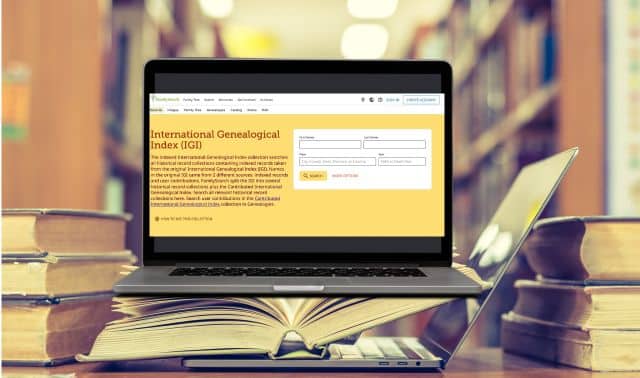Do genealogy records and books read like hieroglyphics? Consult this glossary to decipher unfamiliar lineage lingo.
? abstract: An abbreviated transcription of a document that includes the date of the record and every name it contains, as well as all pertinent information, such as a land description or bequeaths in a will. It may also provide relationships or descriptions (witness, executor, bondsman, son, widow) of the people mentioned.
? Ahnentafel:A German word meaning “ancestor table.” This system of numbering gives each ancestor a number and makes organization and reference easier. Fathers are even numbers; mothers odd. To find a father’s number, double the child’s number (if you are number one, then your father is number two). Add one to the father’s number to get the mother’s number (your mother would be number three).
? ancestors: The relatives you descend from directly, including parents, grandparents, great-grandparents and so on. (See collateral relative.)
? banns (or marriage banns): Church-generated documents publicly stating a couple’s intent to marry. The custom dates to Colonial America; banns were posted or read on three consecutive Sundays.
? bond: A written, signed and witnessed agreement requiring someone to pay a specified amount of money by a given date.
? cemetery records: Records of the names and death dates of those in the cemetery, as well as maps of grave sites. These records usually are kept by cemetery caretakers. More-detailed records, with the names of the deceased’s relatives, may also be included. In addition to these paper records, tombstones also can provide birth and death dates and the names of other family members.
? census: A census is an official count of the population in a particular area. In addition to counting inhabitants, the census generally asks for other details, such as names, ages, citizenship status and ethnicity. The US government began collecting census data in 1790, and has done so every 10 years since. Selected states have conducted their own censuses over the years,
? census date: The designated day in a census year when each household was to count the number of people living in the house on that day. That was the number given to the official census taker. People who were born after that day, but before the census taker came, were not counted. People who were alive on that day, but died before the census taker came, were counted as a member of the household.
? certified copy: An “official,” authorized copy created by the officer or agency that has charge of the original record.
? cluster genealogy: Studying your ancestor as part of a group, or “cluster,” of relatives, friends, neighbors and associates. The cluster approach can help you find (or confirm) details you might miss by looking only at an individual ancestor.
? collateral relative: Any kin who aren’t in your direct line, such as siblings, aunts, uncles and cousins.
? customs lists: Passenger arrival records kept by the US government from 1820 to 1891. The US government pre-printed these forms, and shipping company employees completed them at the port of departure. Customs lists contain limited passenger information, including name, sex, age, occupation and nationality.
? declaration of intention: An alien’s sworn statement that he or she wants to become a US citizen, also called “first papers.” These records, which were filed in federal court, list personal details such as name, age, occupation, birthplace, last foreign residence and more.
? deed: A document transferring ownership and title of property.
? descendant report: A chart or form displaying detailed information about a person’s descendants.
? descendants: An ancestor’s offspring — children, grandchildren and every new generation in the lineage.
? documentation: The process of citing your sources of information. Thorough documentation makes it easier for you to keep track of the details and sources you’ve already researched; it also allows other researchers to verify your findings.
? enumeration districts: Divisions of each county and some large cities used to make census taking more efficient and accurate. For large cities, the boundaries of enumeration districts often match those of wards or precincts.
? family group record (or sheet): This basic form summarizes information on a couple and their children. Includes names; dates and places of birth, baptism, marriage, death and burial; and source citations.
? Family History Library (FHL): The world’s largest genealogical information collection, founded in 1894 by the Church of Jesus Christ of Latter-day Saints in Salt Lake City. Many of the library’s microfilmed records can be loaned for use at one of its 3,700 worldwide Family History Centers, The FHL’s FamilySearch Web site <www.familysearch.org> contains the Social Security Death Index, Military Index, Ancestral File and International Genealogical Index, plus searchable census data from the United States, Canada and the United Kingdom.
? Freeman: Colonial term referring to a man 21 or older who owned property of a certain value. He was obliged to be peaceful. Freemen could vote and pay taxes.
? freed man: A male released from slavery; an emancipated person.
? gazetteer: A geographical dictionary; a book giving names and descriptions of places, usually in alphabetical order.
? GEDCOM: Short for Genealogical Data communications, this is the universal file format for computer-generated family history databases. It allows users of different software programs to share their data.
? genealogy: The study of your family’s history; the process of tracing your ancestors back through time.
? Gregorian calendar: The solar-based calendar instituted by Pope Gregory XIII in 1582. Replaced the Julian calendar, which lagged by 14 days in Pope Gregory’s time, The only difference in the Gregorian calendar is that no century year is a leap year unless it’s divisible by 400.
? homestead: Land granted by the US government. Part of the agreement between the homesteader and the government was that the person had to live on the land and make improvements, such as adding buildings (typically the home the homesteader lived in), clearing fields and planting trees. Also a folksy term used for a spread of land, but not necessarily land granted by the government.
? immigration passenger lists: Passenger arrival records kept by the US government from 1891 and 1954, Like customs lists (left), these forms were created in the United States and completed at the port of departure. But they contain more details about passengers, including birthplaces, last residences, physical descriptions, even names and addresses of relatives in their home countries and America.
? index: An alphabetical list of names taken from a particular set of records. For example, a census index lists the names of people in a particular set of census records, such as the 1870 or 1900 census. Indexes come in book form and on CD-ROM, microfilm, microfiche and the Web.
? International Genealogical Index (IGI): This mammoth genealogical database from the FHL lists dates and places of the births, christenings and marriages of 1 billion people who lived from the early 1500s to the early 1900s. Some data comes from church members’ submissions; the rest has been extracted from original records.
? intestate: Description of a person who died without leaving a will.
? Julian calendar: The calendar used from 46 BC to 1582, and named for Julius Caesar. It’s often referred to as the “Old Style” calendar and was replaced by the Gregorian calendar.
? legacy: Property or money bequeathed to someone in a will.
? lien: A claim placed on property by a person who’s owed money.
? local history: A book about a particular town or county; popular in the late 19th century. They typically include information about prominent families who lived there.
? manuscripts: Handwritten documents and records such as diaries, letters and family Bible entries. You can find manuscript collections by consulting the National Union Catalog of Manuscript Collections (NUCMC), which indexes libraries’ manuscript holdings.
? medical records: Paperwork associated with medical treatments. Because they’re private documents, medical records may not be accessible to the public. But you can sometimes turn up hospital records, doctors’ or midwives’ journals, veterans’ files and asylum records.
? message board: A forum feature on many Web sites that allows you to post your comments and queries for other researchers to read and answer. Most message boards are organized by subject, and series of questions and answers are called “strings” or “threads.”
? military records: Beginning with the American Revolution, records of military service have been kept by the federal government. US military records fall into two categories — compiled service records and veterans’ benefits — and can include volunteer records, pension and bounty-land warrant applications, draft registration cards and military discharge papers.
? Miracode system: An indexing system similar to Soundex used to organize the results of the 1910 census. Miracode cards are computer-generated rather than handwritten, and are organized first by state, Soundex/Miracode code, then alphabetically by first name.
? mortality schedule: A supplement to state and federal censuses with information about people who died in the year prior to the census date. The government took mortality schedules with the 1850 through 1880 censuses.
? National Archives and Records Administration (NARA): The government agency responsible for the United States’ archive of all federal records, including census records, military service rolls and pension applications, passenger lists, bounty-land warrants and American Indian records. In addition to the primary archives in Washington, DC, NARA has a branch in College Park, Md., and 13 regional facilities across the nation.
? National Genealogical Society Quarterly (NGSQ) system: In this numbering system for narrative genealogy reports, every child in a family gets both a Roman numeral and an Arabic numeral. A plus sign indicates that a child appears as a parent in the next generation.
? naturalization records: Documents of the process by which an immigrant becomes a citizen. A person has to live in the United States for a specified period of time and file a series of forms in court before he or she can become naturalized. The records provide a wealth of information about immigrant ancestors (see declaration of intention and petition for naturalization).
? New England Historical and Genealogical Register System: This genealogical numbering system, used in books and reports, shows a person’s descendants arranged by generation. All children in a family get Roman numerals (i, ii, iii …) and every child later listed as a parent also gets an Arabic numeral (2, 3, 4 …) so you can easily trace a family line.
? orphan asylum: An orphanage, or home for children whose parents have died.
? patent: A land grant.
? pedigree: List of a person’s ancestors.
? pedigree chart (or ancestor chart): Basically, your family tree. A five-generation pedigree chart, such as the one on page 61, lists names and vital statistics for ancestors up to your great-great-grand parents.
? pedigree database: A searchable collection of family trees submitted to a Web site or CD by other genealogists; if you find your ancestor in a pedigree database, you usually can download a file with details about multiple generations of the family (see GEDCOM). Pedigree databases let researchers share their work and avoid duplicating efforts. Keep in mind, however, that no one verifies the information people submit to pedigree databases, so you should always verify the data in other sources.
? pension (military): A benefit paid regularly to a veteran (or his widow) for military service or a service-related disability.
? petition for naturalization: An alien’s formal citizenship application, also called “second papers” or “final papers.” The immigrant filed this after submitting the declaration of intention and fulfilling the residency requirement.
? Periodical Source Index (PERSI): An eight-volume index to articles in more than 2,000 genealogy and local history periodicals published in the United States and Canada between 1847 and 1985. PERSI is a project of the Allen County (Ind.) Public Library, and is available in print and on microfiche, CD-ROM and online. The printed volumes go up to 1985; the electronic versions cover through 2002.
? photo-reunion site: A Web site that aims to reunite old photographs found at tag sales or antique stores with family members of the people pictured. Some charge per photo; others consider their mission a public service.
? primary source: A record or other source created at the time of a particular event. A primary source is always the original record — for example, birth and death certificates are primary sources for those events.
? probate records: Records disposing of a deceased individual’s property. They may include a person’s last will and testament, if one was made. The information you can get from probate records generally includes the deceased’s name, property, members of the family and the last place of residence. Sometimes includes the age at the time of death (or birth date).
? real property: Land and anything attached to it, such as houses, buildings, barns, growing timber and growing crops.
? search engine: A Web site such as Google <www.google.com> or AltaVista <www.altavista.com> that allows you to input search terms and will return all matching entries available on the Internet.
? secondary source: A record created after an event occurred, such as a biography, local history, index, or computer database. Use the details you find in secondary sources as clues until you can verify them in original records.
? self-addressed, stamped envelope (SASE): When you request records or other information from people and institutions, you should include a self-addressed, stamped envelope (SASE) in your letter.
? Social Security Death Index (SSDI): A computer database of Social Security death records from 1937 to the present.
? Soundex: A system of coding surnames phonetically, used to index the 1880 and later censuses. Soundex helps you locate records containing alternate surname spellings. Soundex cards are arranged by state, Soundex code, then alphabetically by first name and, if necessary, alphabetically by place of birth.
? township: In a government survey, it’s a square tract six miles on each side (36 square miles); a name given to the civil and political subdivisions of a county.
? visitation number: On a 1910 Miracode index card, the house number of the indexed individual.
? vital records: Birth, marriage, death and divorce records created by some division of the government. Many vital records are created at the town or county level; copies also are kept at the state level.
? volume number: On a Soundex or Miracode card, the number of the census volume in which the indexed name appears.
From Family Tree Magazine‘s November 2003 Trace Your Family History.



